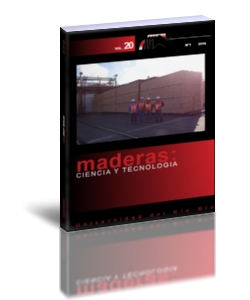Effect of pole size on preservative penetration and retention in air-dried ugandan grown eucalypt utility poles
Keywords:
Creosote, Eucalyptus grandis, transmission poles, treated wood, wood preservationAbstract
Treated wooden utility poles, from trees such as eucalypts, are the most commonly used for telephone and electricity transmission lines in Uganda. In the last decade, however, frequent failure of wooden poles in service has been reported, likely due to the preservative chemical, wood used or the treatment process. The objective of this study was to assess the creosote preservative penetration and retention in eucalypt wood. A total of 126 Eucalyptus grandis poles i.e. 42 poles for each size category, with an average moisture content of below fibre saturation point (28%) were treated in different charges depending on their size. In length, poles used were 9, 11 and 14m. Every charge consisted of poles within the same size category. The Full Cell pressure method was used to treat the different charges with creosote preservative. For all the charges the same treatment schedule was maintained. Creosote penetration was highest in 14m poles (20.5mm) and lowest in 9m poles (18.4mm), Creosote retention was also highest in 14m poles (193kgm-3), but lowest in 11m poles (162kgm-3). Irrespective of differences in level of penetration and retention among the various pole sizes, all the poles acquired more than the required standard minimum level of penetration and retention i.e. 15mm and 115kgm-3 respectively. However, for all the pole sizes, creosote penetration was less than the sapwood depth. The current treatment schedule seems better suited for the larger poles of 14m than the 9 and 11m. For better treatment, it is recommended that smaller poles i.e. 9m and 11m should be treated for a longer period than 14m poles since they tend to have lager sapwood. The minimum basis of 15mm penetration should be increased to at least cover the entire pole sapwood depth.
Downloads
References
Blew, J.O.; Davidson, H.L. 1971. Preservative retentions and penetration in the treatment of white fir. Proceedings of American Wood Preservers’ Association 67: 204-221.
Cookson, L.J. 2000. The preservation of eucalypts. In: The future of eucalypts for wood products. Proceedings IUFRO conference; 19-24 March, 2000; Launceston, Tasmania. IUFRO; 2000. 248-255.
EAS 323:2002. 2002. Specification for wood preservation by means of pressure creosoting. East African Standard, 1st edition.
Lebow, S.; Cooper, P; Lebow, P. 2004. Variability in Evaluating Environmental Impacts of Treated Wood. Proceedings of The Environmental Impacts of Preservative-Treated Wood Conference Orlando, Florida. February 2004.
PIESA 1001:2004. 2004. Specifications for treatment of Wood Poles, Cross-arms and Spacer Blocks. The Power Institute for East and Southern Africa.
Rice, R. W.; Onofrio, M. 1996. Longitudinal gas permeability measurements from Eastern white pine, Red spruce and Balsam fir. Wood and Fiber science 28 (3): 301-308.
Siau, J. F. 1984. Transport process in wood. Springer, Heidelberg.
Wang, J.Z.; DeGroot, R. 1990. Treatability and Durability of Heartwood. Institute of wood research, Michigan Tech, Houghton.
White F. M. 1974. Viscous Fluid Flow. MaGraw Hill, New York.

































